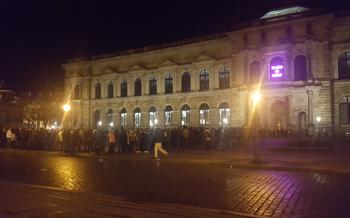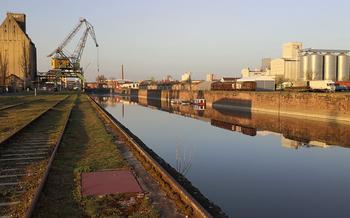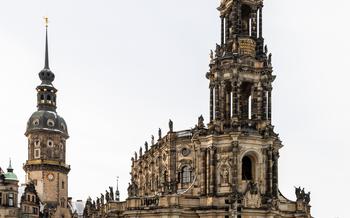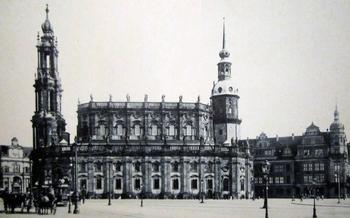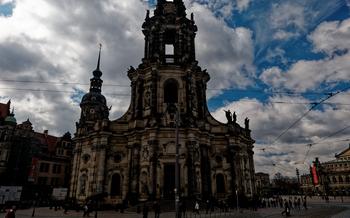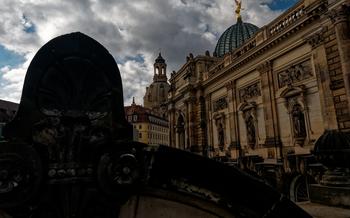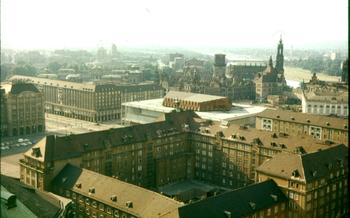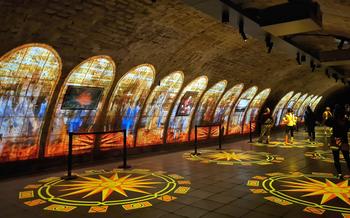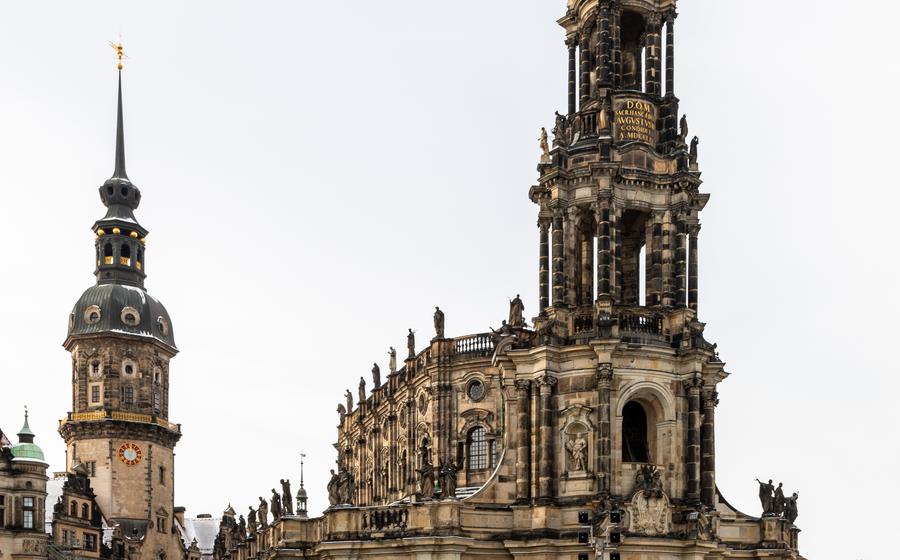
Dresden Cathedral (Cathedral of the Holy Trinity)
- History and Significance
- Architecture and Design
- Religious Importance
- Historical Events and Personalities
- Restoration and Reconstruction
- Visiting the Cathedral
- Exploring the Interior
- Attending Mass or Services
- Views from the Cathedral
- Exploring the Cathedral Surroundings
- Unforgettable Moments:
- Tips for Photography Enthusiasts:
- Events and Exhibitions
- Accessibility and Facilities
- Insider Tip: Unveiling the Hidden Jewel of Dresden Cathedral
History and Significance
The Dresden Cathedral, officially known as the Cathedral of the Holy Trinity, stands as a testament to Dresden's rich history and cultural heritage. Constructed between 1738 and 1755, the cathedral is a masterpiece of Baroque architecture, designed by the renowned architect Gaetano Chiaveri. It serves as the seat of the Dresden Diocese and is considered one of Germany's most significant Catholic churches.
Throughout its existence, the Dresden Cathedral has witnessed numerous historical events. Tragically, it was severely damaged during the devastating air raids of World War II, leaving only its outer walls intact. However, the cathedral's resilience and determination led to its remarkable reconstruction, which was completed in 196This restoration symbolized Dresden's ability to rise from the ashes and rebuild its cultural treasures.
The Dresden Cathedral boasts a unique architectural style, blending Italian Baroque and German Rococo elements. Its majestic dome, towering at 95 meters, dominates the cityscape and offers breathtaking views of Dresden. The cathedral's exterior is adorned with intricate sculptures and reliefs, showcasing scenes from the Bible and the lives of saints.
The cathedral's interior is equally impressive, featuring a vast nave, elegant side aisles, and a stunning high altar. Its walls are adorned with exquisite paintings, sculptures, and stained glass windows, narrating biblical stories and the history of the Catholic Church. The Dresden Cathedral is not just a religious landmark but also a symbol of Dresden's unwavering spirit, a testament to its cultural and historical significance.
Architecture and Design
The Dresden Cathedral's architectural style is a masterful blend of Baroque and Renaissance elements, showcasing an intricate fusion of grandiosity and elegance. The exterior facade is adorned with ornate sculptures, intricate carvings, and delicate tracery, creating a visually captivating spectacle. Two striking domes, each topped with a golden cross, dominate the skyline and serve as iconic symbols of the cathedral.
Inside, the cathedral's grandeur continues. The nave, with its soaring vaulted ceilings, is supported by massive pillars that create a sense of awe and wonder. Every corner of the interior is adorned with exquisite artwork, including intricate frescoes, elaborate altars, and finely crafted sculptures.
Notable Features:
-
Domes: The two massive domes, visible from afar, symbolize the cathedral's celestial aspirations and are a testament to the architectural prowess of the era.
-
Towers: The cathedral boasts two slender towers that flank the main entrance, adding to its majestic appearance and providing picturesque views of the cityscape.
-
Sculptures: The exterior and interior of the cathedral are adorned with numerous sculptures, each depicting religious figures or scenes from the Bible, adding depth and narrative to the architectural masterpiece.
-
Stained Glass Windows: The cathedral's stained glass windows are a true work of art, casting a kaleidoscope of colors onto the interior and illuminating the sacred space with ethereal beauty.
Religious Importance
As a prominent symbol of Catholicism in Dresden, the cathedral serves as a significant place of worship for the city's Catholic community. With its rich history and sacred atmosphere, the cathedral attracts believers who seek spiritual guidance and connection with the divine. Throughout the year, the cathedral hosts various religious ceremonies, including Mass, baptisms, weddings, and funerals.
These ceremonies, conducted by the resident priests, play a crucial role in the religious life of Dresden's Catholic faithful. The cathedral also offers opportunities for prayer, contemplation, and spiritual reflection. Visitors can find solace and inspiration within the cathedral's serene and hallowed halls, fostering a deep sense of connection with their faith and beliefs.
Historical Events and Personalities
The Dresden Cathedral has witnessed numerous significant historical events throughout its existence. During the Reformation, Martin Luther, a prominent figure in the Protestant movement, preached at the cathedral in 1522, leaving a lasting impact on the religious landscape of Dresden. In the 18th century, the cathedral served as the backdrop for the wedding of Augustus the Strong, Elector of Saxony, to Maria Josepha of Austria, a grand event that showcased the opulence and grandeur of the era. Tragically, during World War II, the cathedral suffered severe damage from Allied bombings, leaving only its outer walls standing. Its subsequent reconstruction symbolized the resilience and determination of the people of Dresden to rebuild their city and preserve its cultural heritage.
Restoration and Reconstruction
After the devastating air raids during World War II, the Dresden Cathedral lay in ruins, its once-glorious silhouette reduced to a pile of rubble. The loss of this architectural masterpiece was a profound blow to the city and its people. However, the indomitable spirit of Dresdeners prevailed, and they embarked on an ambitious mission to resurrect their beloved cathedral.
The restoration and reconstruction process was a monumental undertaking, spanning several decades and requiring meticulous attention to detail. Craftsmen, architects, and historians worked tirelessly to piece together the cathedral's intricate structure, using salvaged fragments and relying on historical documentation to guide their efforts.
The task was fraught with challenges. The original plans had been destroyed in the war, and the extent of the damage meant that much of the cathedral had to be rebuilt from scratch. Moreover, the political division of Germany during the Cold War further complicated the restoration efforts.
Despite these obstacles, the determination of the Dresdeners remained unwavering. The restoration of the cathedral became a symbol of hope and resilience, a testament to their unwavering belief in the city's ability to rise from the ashes of war.
The culmination of decades of painstaking work was a triumphant moment for Dresden. In 2005, the fully restored Dresden Cathedral reopened its doors, once again standing as a beacon of faith, history, and cultural heritage in the heart of the city. Its resurrection served as a poignant reminder of the indomitable spirit of Dresden and its people, who had risen from the depths of despair to rebuild their beloved city and preserve its treasured landmarks.
Visiting the Cathedral
Whether you're a history buff, an architecture enthusiast, or simply seeking spiritual enlightenment, visiting the Dresden Cathedral is an enriching experience not to be missed. Opening its doors to the public daily, the cathedral welcomes visitors from all walks of life. Admission is free, allowing everyone the opportunity to marvel at its grandeur. Guided tours are available for a deeper dive into the cathedral's history, symbolism, and architectural intricacies.
For a serene and contemplative experience, plan your visit during the week, avoiding the weekend crowds. The cathedral is open from morning until evening, giving you ample time to explore its every corner at your own pace. Remember to dress respectfully, as the cathedral is an active place of worship.
Exploring the Interior
Stepping inside the Dresden Cathedral is like stepping back in time to an era of grandeur and devotion. The cathedral's interior is a testament to the skill and artistry of the craftsmen who built it. The nave, with its soaring Gothic arches, leads the eye towards the ornate high altar, a masterpiece of Baroque craftsmanship. The intricate carvings, delicate sculptures, and vibrant colors of the altar create a sense of awe and wonder.
Notable features of the interior include the pulpit, crafted from alabaster and adorned with intricate carvings depicting scenes from the Bible. The organ, with its impressive array of pipes, fills the cathedral with melodious sounds during services and concerts.
The stained glass windows, a kaleidoscope of colors, depict biblical scenes and saints, casting a warm and ethereal glow throughout the cathedral. Each window tells a story, inviting visitors to contemplate the rich history and faith that this sacred space represents.
The cathedral's interior is a treasure trove of religious symbols and artwork, each with its own significance. From the intricate carvings on the choir stalls to the delicate frescoes on the walls, every detail has been carefully considered to create a harmonious and uplifting environment for worship and reflection.
Attending Mass or Services
If you're a devout Catholic or simply seeking a spiritual experience, attending Mass or other religious services at the Dresden Cathedral is a profound and enriching opportunity. The cathedral's sacred atmosphere and beautiful surroundings provide a serene environment for contemplation and worship.
Mass is held daily, with specific times varying depending on the day of the week. For the most up-to-date schedule, visitors can check the cathedral's website or inquire at the information desk. Additionally, special services and celebrations, such as Easter or Christmas masses, are held throughout the year.
Before attending a service, it's important to dress respectfully and adhere to the cathedral's etiquette. Modest clothing that covers the shoulders and knees is appropriate. During the mass, visitors are encouraged to follow the lead of the congregation, standing, kneeling, and sitting as indicated.
Attending a service at the Dresden Cathedral offers a unique opportunity to immerse oneself in the spiritual and cultural heritage of this iconic landmark. Whether you're a regular churchgoer or simply seeking a moment of peace and reflection, the cathedral's sacred space welcomes all visitors with open arms.
Views from the Cathedral
The Dresden Cathedral offers breathtaking panoramic views of the city from its tower or dome (if accessible), providing a unique perspective on Dresden's cityscape. From this elevated vantage point, visitors can admire the intricate details of the cathedral's architecture, including its domes, towers, and sculptures. The views extend far beyond the cathedral grounds, allowing visitors to take in the entire city and its surroundings. Notable landmarks such as the Frauenkirche, Zwinger Palace, and Elbe River can be easily spotted from the cathedral's viewpoint. These views help visitors understand the historical significance of the cathedral and its role in shaping Dresden's skyline. Capturing the beauty of Dresden from the cathedral's tower or dome is a must-do for any visitor, offering a lasting memory of this iconic landmark.
Exploring the Cathedral Surroundings
Beyond the awe-inspiring interiors of the Dresden Cathedral, the surrounding area is a treasure trove of architectural wonders and historical landmarks. A short stroll from the cathedral, visitors can marvel at the grandeur of the Dresden Royal Palace, a magnificent Baroque masterpiece that once housed the Saxon rulers. The palace now serves as a museum, showcasing a captivating collection of art, weaponry, and royal artifacts.
Just across the Elbe River, the Zwinger Palace beckons with its opulent Rococo architecture. This former orangery and festival ground is now home to several museums, including the Gemäldegalerie Alte Meister, which houses a world-renowned collection of old master paintings. The Zwinger's expansive gardens offer a serene oasis amidst the city's vibrant energy.
Another must-visit attraction is the Semperoper, Dresden's iconic opera house. With its lavish auditorium and impressive acoustics, the Semperoper has hosted legendary performances and premiered countless operas throughout its storied history. Guided tours provide a glimpse into the theater's rich heritage and intricate stage machinery.
The cathedral's surroundings are also dotted with charming cafes, inviting restaurants, and boutique shops. Visitors can savor delicious Saxon cuisine, indulge in retail therapy, or simply soak in the vibrant atmosphere of this historic neighborhood.
Unforgettable Moments:
My first encounter with the Dresden Cathedral left an enduring imprint on my memory. As I stepped inside, the vastness of the interior enveloped me, creating a sense of awe and wonder. The intricate stained glass windows cast a kaleidoscope of colors that danced upon the marble floors, illuminating the grandeur of the space.
While exploring the cathedral, I stumbled upon a hidden gem: a small, secluded chapel nestled away from the main thoroughfare. Inside, I discovered an exquisite altarpiece adorned with intricate carvings and delicate gold leaf. The peace and tranquility of the chapel provided a sanctuary from the bustling activity outside, allowing me to connect with the spiritual essence of the cathedral.
As I exited the cathedral, I paused to admire the magnificent dome that towered above me. The intricate details of its design were breathtaking, and the sheer size of the structure filled me with a sense of humility. The Dresden Cathedral had left an indelible mark on my soul, and I knew that I would forever cherish the memories of my visit.
Tips for Photography Enthusiasts:
The Dresden Cathedral offers ample opportunities for photography enthusiasts to capture stunning images. Here are a few tips to help you make the most of your photography experience:
-
Utilize the Golden Hour: Plan your visit during the golden hour, just after sunrise or before sunset, when the warm, soft light enhances the cathedral's beauty.
-
Experiment with Different Perspectives: Explore different angles and perspectives to create unique compositions. Capture the cathedral's grandeur from a distance, or get up close to highlight its intricate details.
-
Focus on Architectural Details: Pay attention to the cathedral's architectural elements, such as the domes, towers, and sculptures. Use a wide-angle lens to capture the entire structure or a telephoto lens to zoom in on specific details.
-
Pay Attention to Lighting: The cathedral's interior is dimly lit, so adjust your camera settings accordingly. Use a tripod to stabilize your camera and reduce camera shake.
-
Respectful Photography: While taking photographs, be mindful of other visitors and avoid disrupting religious services or ceremonies. Respect the sanctity of the space and follow any photography guidelines or restrictions posted within the cathedral.
Events and Exhibitions
The Dresden Cathedral is not just a place of worship but also a vibrant cultural hub that hosts a variety of events and exhibitions throughout the year. These events showcase the cathedral's rich history, art, and music, offering visitors a unique opportunity to experience the cathedral's spiritual and cultural significance.
One of the most notable events is the Dresden Cathedral Music Festival, an annual event that brings together renowned musicians and choirs from around the world. The festival features a diverse range of concerts, from classical to contemporary, performed within the cathedral's awe-inspiring acoustics.
The cathedral also hosts regular art exhibitions, showcasing the works of local and international artists. These exhibitions often explore themes related to the cathedral's history, architecture, and religious significance. Visitors can admire paintings, sculptures, and installations that offer a fresh perspective on this iconic landmark.
During the Christmas season, the cathedral transforms into a magical winter wonderland, hosting festive concerts, markets, and events. The cathedral's interior is adorned with elaborate decorations, creating a warm and inviting atmosphere for visitors to celebrate the holiday season.
Whether you're a music lover, an art enthusiast, or simply seeking a unique cultural experience, the Dresden Cathedral offers a variety of events and exhibitions that will enrich your visit and deepen your understanding of this remarkable landmark.
Accessibility and Facilities
The Dresden Cathedral is committed to providing an accessible and welcoming environment for all visitors. Wheelchair ramps and elevators ensure that individuals with mobility challenges can navigate the cathedral's interior with ease. For those seeking a deeper understanding of the cathedral's history and architecture, guided tours are available in multiple languages, providing a comprehensive overview of this iconic landmark.
Restrooms are conveniently located within the cathedral, ensuring that visitors can comfortably explore the premises. Additionally, a gift shop offers a range of souvenirs, including books, postcards, and religious artifacts, allowing visitors to take a piece of the cathedral's history home with them. For those looking to grab a bite to eat, a café is situated nearby, offering refreshments and light meals. Parking options are available in the vicinity of the cathedral, ensuring a hassle-free visit for those arriving by car.
Insider Tip: Unveiling the Hidden Jewel of Dresden Cathedral
Amidst the grandeur of the Dresden Cathedral, a captivating secret awaits discovery. Concealed within the depths of the cathedral's treasury lies a priceless artifact that has captivated the hearts of many - the "Grüne Gewölbe" (Green Vault). This extraordinary collection of treasures, amassed over centuries by the Electors of Saxony, is a testament to the opulence and artistry of the past. From intricate goldsmithing to precious gemstones, the Green Vault showcases a dazzling array of masterpieces that will leave you spellbound. Make sure to include this hidden gem in your visit to the Dresden Cathedral and immerse yourself in the splendor of its remarkable treasures.
